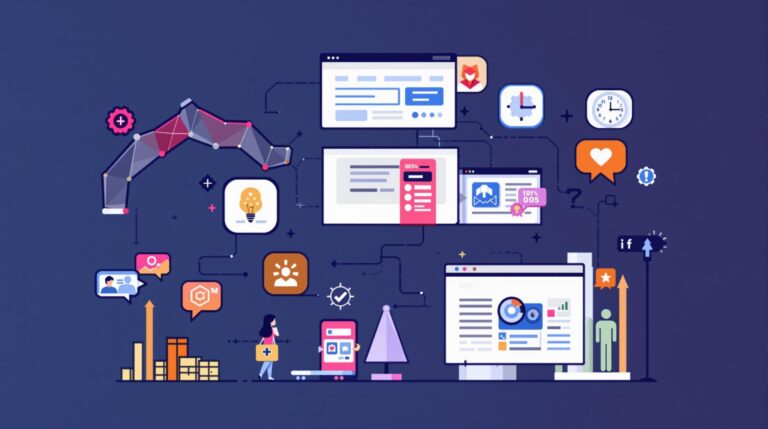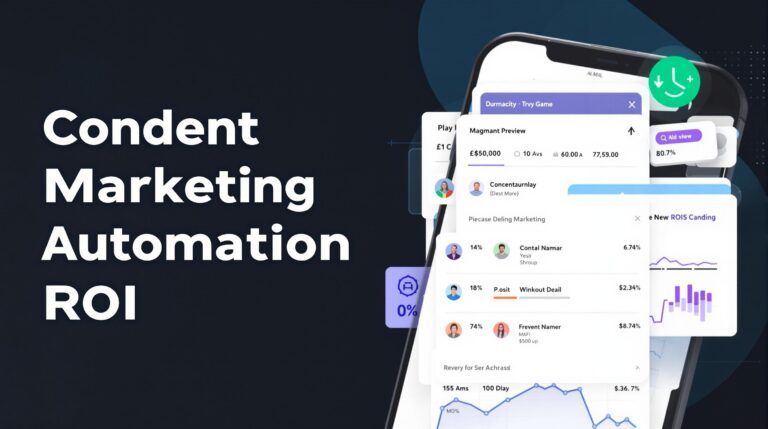How to Create a Seamless Content Automation Strategy from Start to Finish
Creating a comprehensive content automation strategy has become essential for modern marketing teams seeking to scale their efforts while maintaining quality. Implementing the right combination of AI tools, workflow processes, and measurement frameworks can transform how businesses approach content creation and distribution. A well-structured content automation strategy not only saves valuable time but also significantly improves marketing performance across multiple channels and touchpoints.
Key Takeaways
- 68% of marketers report positive ROI from AI-powered analytics dashboards
- Successful automation requires clear goal setting and audience segmentation before tool implementation
- The most effective strategies combine AI generation with human oversight (70% of successful brands use this approach)
- Automated publishing across channels can increase engagement by up to 157% when combined with video content
- Regular measurement and optimization are critical components of any content automation system
https://www.youtube.com/watch?v=HcuqPc3lWxk
Setting Strategic Goals for Your Content Automation
Before diving into tool selection, I recommend establishing clear, measurable objectives for your content automation strategy. According to research from ClearVoice, 76% of marketers using account-based marketing (ABM) approaches report higher ROI than traditional strategies. This highlights the importance of goal-driven automation tied to specific business outcomes.
Start by defining concrete KPIs like “Increase organic traffic by 30% in Q3” or “Generate 200 qualified leads per month.” These goals should connect directly to broader business objectives rather than vanishing into marketing metrics that executives don’t value. Your automation tools should then be selected based on their ability to help achieve these specific targets.
Audience understanding forms the foundation of effective automation. With 80% of companies now prioritizing personalization as critical for growth, your strategy must include creating detailed buyer personas using both demographic and behavioral data. Use analytics tools to identify specific pain points across different audience segments – for example, B2B tech buyers might prefer in-depth case studies, while e-commerce audiences engage more with product videos.

Implementing AI-Powered Content Creation Tools
The core of any content automation strategy involves selecting the right content automation tools for your specific needs. Modern AI writing assistants can save professionals approximately one full day per week in productivity, according to research from Aventi Group. However, it’s important to note that 70% of brands achieving success with AI content pair automated generation with human oversight.
When selecting content creation tools, consider these popular options:
- Jasper and ChatGPT for initial draft generation (used by 46% of marketers for copywriting)
- Semrush’s Keyword Magic Tool ($117/month) for SEO-optimized content planning
- Copy.ai for social media captions and email subject lines
- SEO Content Machine ($27/month) for multilingual content generation
The most effective approach isn’t about replacing human creativity but augmenting it. I’ve found that using AI tools to handle repetitive tasks like headline generation, meta descriptions, and initial outlines frees up creative resources for strategic thinking and content differentiation. According to Writesonic, content over 3,000 words generates three times more traffic than shorter posts, making AI assistance particularly valuable for creating comprehensive long-form content.
Building Automated Distribution Workflows
Creating content is only half the battle – efficient distribution is equally important. Research from Omnitas shows that businesses publishing 16+ monthly blog posts generate 4.5 times more leads than those publishing less frequently. Automation makes this volume manageable.
Implementing a streamlined distribution workflow typically involves:
- Using scheduling tools like Hootsuite or Buffer ($24/month) to queue content for optimal posting times
- Setting up API integrations between your content management system and social platforms
- Creating email sequences triggered by specific user behaviors (93% of successful ABM campaigns use this approach)
- Implementing cross-channel publishing to maintain presence across multiple platforms
Automated cross-platform posting has been shown to increase engagement by 157% when paired with video content. For example, you might automate your blog content creation process to include automatic social promotion whenever a new post goes live.
Tools like SocialBee ($24/month) can generate AI-powered social captions tailored to each platform, while WordPress plugins like Jetpack can automate CMS publishing during peak traffic windows. The goal is creating a seamless system where content flows automatically through your marketing channels based on pre-defined rules and schedules.
Measuring Performance and Optimizing Your Strategy
A truly effective content automation strategy requires continuous measurement and refinement. According to Adobe, 68% of marketers report ROI from AI investments when using analytics dashboards to track performance. Without proper measurement, automation simply scales potentially ineffective content.
Key performance tracking approaches include:
- Configuring Google Analytics 4 dashboards to track engagement metrics by content type
- Implementing A/B testing for headlines and content elements (this can increase CTR by 42%)
- Using HubSpot’s AI-powered recommendations ($800+/month) to refine topic clusters
- Automating weekly performance reports that highlight top-performing assets
The data collected should directly inform your content automation decisions. For example, if analytics reveal that how-to articles consistently outperform thought leadership pieces, you might adjust your content automation strategy to prioritize instructional content. This creates a virtuous cycle where automation becomes increasingly effective over time.
Creating a Multi-Channel Content Ecosystem
Modern content consumption happens across multiple platforms, requiring a cohesive automation approach that maintains brand consistency while adapting to channel-specific requirements. The ultimate guide to content automation demonstrates how important cross-channel consistency has become.
To build a multi-channel content ecosystem, I recommend:
- Developing standardized content templates that maintain brand voice across channels
- Using SEO Content Machine to generate multilingual variations for international audiences
- Implementing Jetpack AI Assistant for WordPress-integrated content optimization
- Leveraging tools like AppEQ.ai to auto-generate data-driven reports from your content analytics
This approach enables you to maintain a consistent brand presence while adapting content format and delivery method to match audience expectations on each platform. For example, a single research report might automatically spawn a blog post, social media graphics, an email newsletter, and a video script – all following brand guidelines but optimized for their specific channels.
Implementing Personalization at Scale
With 80% of companies now prioritizing personalization as critical for growth, your content automation strategy must include mechanisms for delivering tailored experiences to different audience segments. Traditional manual personalization is time-consuming, but automation makes it scalable.
Effective personalization automation includes:
- Using dynamic buyer personas to create targeted content streams
- Integrating CRM data with content delivery platforms like HubSpot
- Implementing chatbots like Drift to deliver personalized content recommendations during site visits
- Setting up behavioral triggers that serve relevant content based on user actions
The most advanced personalization systems use predictive analytics to anticipate user needs rather than simply reacting to them. For example, an AI-driven system might detect that a prospect has viewed several product pages without converting, then automatically trigger an email offering a related case study that addresses common objections.
Future-Proofing Your Content Automation Strategy
According to Gartner, by 2025, 70% of customer interactions will involve AI-driven content. This rapid evolution means your content automation strategy needs to accommodate emerging technologies and changing consumer expectations.
To future-proof your approach, consider investing in:
- Predictive analytics tools that automate content updates based on real-time trends
- AI-powered chatbots that will drive 58% of personalization efforts by 2026
- Platforms like Synthesia for AI-generated video content from text assets
- Tools that support voice search optimization as audio interfaces grow
Staying current with emerging technologies is essential for maintaining a competitive content automation strategy. The organizations that thrive will be those that balance human creativity with AI efficiency, creating systems that can adapt to changing platforms and audience preferences while maintaining brand authenticity.
Sources
Writesonic – Content Automation Strategy: Essential Steps and Tools [2024]
Omnitas – Tools, Tips, and Strategies for Automating Content Creation
ClearVoice – 35 Content Marketing Statistics
Filestage – Content Automation Tools
Adobe – Content Marketing Basics
Aventi Group – What is Content Automation?
Jetpack – How to Automate Content Creation
AppEQ – Future of Data-Driven Content Automation








